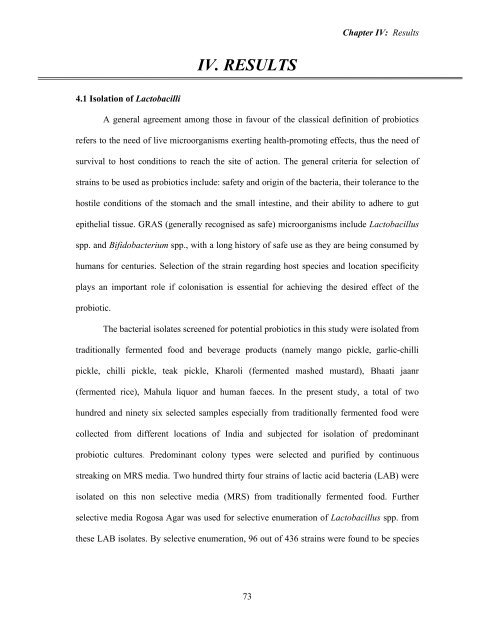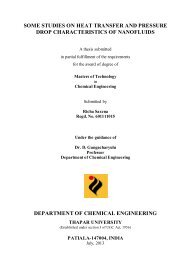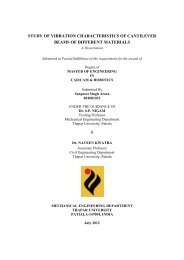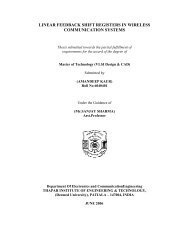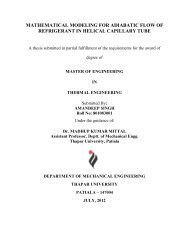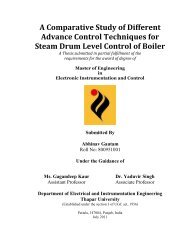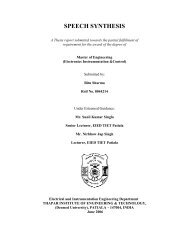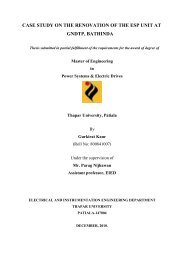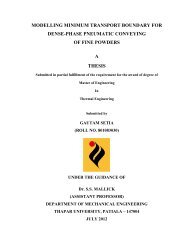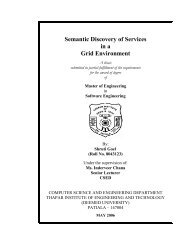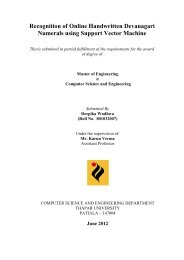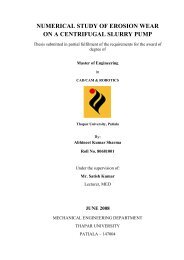from indigenous fermented foods and human gut ... - Thapar University
from indigenous fermented foods and human gut ... - Thapar University
from indigenous fermented foods and human gut ... - Thapar University
You also want an ePaper? Increase the reach of your titles
YUMPU automatically turns print PDFs into web optimized ePapers that Google loves.
4.1 Isolation of Lactobacilli<br />
IV. RESULTS<br />
73<br />
Chapter IV: Results<br />
A general agreement among those in favour of the classical definition of probiotics<br />
refers to the need of live microorganisms exerting health-promoting effects, thus the need of<br />
survival to host conditions to reach the site of action. The general criteria for selection of<br />
strains to be used as probiotics include: safety <strong>and</strong> origin of the bacteria, their tolerance to the<br />
hostile conditions of the stomach <strong>and</strong> the small intestine, <strong>and</strong> their ability to adhere to <strong>gut</strong><br />
epithelial tissue. GRAS (generally recognised as safe) microorganisms include Lactobacillus<br />
spp. <strong>and</strong> Bifidobacterium spp., with a long history of safe use as they are being consumed by<br />
<strong>human</strong>s for centuries. Selection of the strain regarding host species <strong>and</strong> location specificity<br />
plays an important role if colonisation is essential for achieving the desired effect of the<br />
probiotic.<br />
The bacterial isolates screened for potential probiotics in this study were isolated <strong>from</strong><br />
traditionally <strong>fermented</strong> food <strong>and</strong> beverage products (namely mango pickle, garlic-chilli<br />
pickle, chilli pickle, teak pickle, Kharoli (<strong>fermented</strong> mashed mustard), Bhaati jaanr<br />
(<strong>fermented</strong> rice), Mahula liquor <strong>and</strong> <strong>human</strong> faeces. In the present study, a total of two<br />
hundred <strong>and</strong> ninety six selected samples especially <strong>from</strong> traditionally <strong>fermented</strong> food were<br />
collected <strong>from</strong> different locations of India <strong>and</strong> subjected for isolation of predominant<br />
probiotic cultures. Predominant colony types were selected <strong>and</strong> purified by continuous<br />
streaking on MRS media. Two hundred thirty four strains of lactic acid bacteria (LAB) were<br />
isolated on this non selective media (MRS) <strong>from</strong> traditionally <strong>fermented</strong> food. Further<br />
selective media Rogosa Agar was used for selective enumeration of Lactobacillus spp. <strong>from</strong><br />
these LAB isolates. By selective enumeration, 96 out of 436 strains were found to be species


